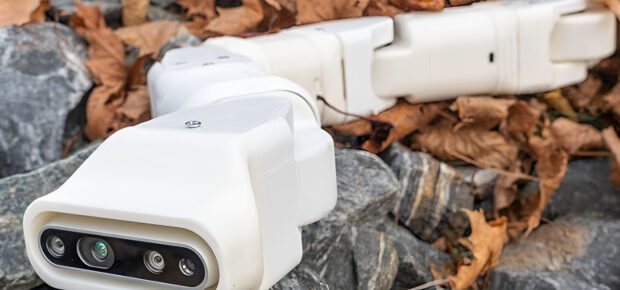February 15, 2024
Snakes are remarkably agile. They can move on land by pushing against rocks, branches and other physical objects. They can swim and climb. Some can even glide through the air.
As a result, they’re found in a variety of environments: in sand and on stone, in trees, in oceans and in freshwater, and in narrow passages. And, as an added bonus, they can wrap around objects like trees.
Because of these capabilities, snakes are increasingly providing inspiration for robot design. Snake robots imitating this wide array of actions could do a variety of things, such as explorations of earthquake-hit areas, inspections for the oil and gas industry, fire-fighting operations and search-and-rescue (SAR) activities.
Introducing the snake cobot
In emergency situations, snake robots could be outfitted with sensors and specialized equipment. But their usefulness goes beyond that. Rather than viewing snake robots as tools or mobile sensor carriers, they can be viewed as team members, especially in unpredictable environments such as disaster zones, and in emergency circumstances.
Collaborative robots, cobots for short, represent the idea of Human-Robot Teaming (HRT). This implies that humans and robots team up to tackle tasks that neither can complete on their own. When considering this paradigm, working steps are simultaneous, working spaces are shared, working tasks are dependent, and physical contact is possible, often desired. This represents a fundamental shift from traditional robots, which were not sharing spaces nor forces with humans.
A snake cobot can integrate technologies like augmented reality, digital twinning, and artificial intelligence to foster more effective control and actuation, yielding enhanced problem-solving abilities, adaptability, and efficiency, particularly in dynamically changing environments like disaster zones.
How Snake Cobots Navigate the World
When a snake robot moves through a cluttered environment by pushing against walls or other external objects (anything but flat ground), we refer to that as obstacle-aided locomotion (OAL). But the ability to map and perceive the world is of fundamental importance. When robots use a sensory-perceptual system to exploit its surrounding operational space, we call this perception-driven, obstacle-avoidance locomotion (POAL).
Achieving POAL requires precisely identifying potential push-points and accurately applying the force necessary to move the robot. Accomplishing this with traditional rigidly-actuated robots is exceedingly demanding because they are not supple and flexible.
One such snake cobot, known as Serpens, has been designed to be cost-effective, open-source, and highly flexible. It uses a technology called a “series elastic actuator” to accomplish POAL, which was previously challenging with rigid robots.
How Snake Cobots Could Be Used
In the aftermath of earthquakes, accidents, avalanches, or explosions, snake cobots can work with human counterparts to increase the possibility of rescuing people.
Because of the way they move, snake cobots enable unique capabilities in places that humans might find too difficult or too dangerous to reach. In particular, snake cobots could enlarge passages around victims by grabbing things or pushing them out of the way to allow rescuers to gain access. Or they could pass through areas that would also be blocked to human rescuers for search purposes. They could bring first aid supplies or medicine to the trapped people.
How People React to Snakes
One question facing the makers of snake robots is whether people being rescued want to confront anything in snake form. Numerous studies have examined how humans view and react to robots, as well as how robots should interact with people. Techniques exist to estimate people’s behavior in specific circumstances. The way a snake cobot interacts with humans must take several factors into account. It is crucial to study how a snake cobot might approach a person and convey its intentions through nonverbal clues. During emergency situations, nonverbal cues may be more appropriate and less stressful compared to verbal communication or other forms of communication that rely heavily on language or speech. These nonverbal cues can be achieved through different robot gaits or by employing a multi-modal feedback system involving auditory, visual, and tactile stimuli. In particular, snake cobots could convey critical tactile information by using haptics, such as pressure, vibrations, or textures, to improve communication and comprehension between the robot and potential victims, or between the robot and first responders. This tactile feedback could help snake cobots and people establish trust, provide guidance, and promote successful HRT in critical circumstances.
ABOUT OUR AUTHOR
Filippo Sanfilippo is an IEEE Senior Member whose work focuses on robotics and machine learning. He is a member of the IEEE Public Visibility Committee and a former chair of IEEE Norway Section.





 Liquid Infrastructure: Our Planet's Most Precious Resource
Liquid Infrastructure: Our Planet's Most Precious Resource The Impact of Technology in 2025
The Impact of Technology in 2025 Quantum and AI: Safeguards or Threats to Cybersecurity?
Quantum and AI: Safeguards or Threats to Cybersecurity? Why AI Can't Live Without Us
Why AI Can't Live Without Us Bits, Bytes, Buildings and Bridges: Digital-Driven Infrastructure
Bits, Bytes, Buildings and Bridges: Digital-Driven Infrastructure Impact of Technology in 2024
Impact of Technology in 2024 Emerging AI Cybersecurity Challenges and Solutions
Emerging AI Cybersecurity Challenges and Solutions The Skies are Unlimited
The Skies are Unlimited Smart Cities 2030: How Tech is Reshaping Urbanscapes
Smart Cities 2030: How Tech is Reshaping Urbanscapes Impact of Technology 2023
Impact of Technology 2023 Cybersecurity for Life-Changing Innovations
Cybersecurity for Life-Changing Innovations Smarter Wearables Healthier Life
Smarter Wearables Healthier Life Infrastructure In Motion
Infrastructure In Motion The Impact of Tech in 2022 and Beyond
The Impact of Tech in 2022 and Beyond Cybersecurity, Technology and Protecting Our World
Cybersecurity, Technology and Protecting Our World How Technology Helps us Understand Our Health and Wellness
How Technology Helps us Understand Our Health and Wellness The Resilience of Humanity
The Resilience of Humanity Harnessing and Sustaining our Natural Resources
Harnessing and Sustaining our Natural Resources Creating Healthy Spaces Through Technology
Creating Healthy Spaces Through Technology Exceptional Infrastructure Challenges, Technology and Humanity
Exceptional Infrastructure Challenges, Technology and Humanity The Global Impact of IEEE's 802 Standards
The Global Impact of IEEE's 802 Standards Scenes of our Cyber Lives: The Security Threats and Technology Solutions Protecting Us
Scenes of our Cyber Lives: The Security Threats and Technology Solutions Protecting Us How Millennial Parents are Embracing Health and Wellness Technologies for Their Generation Alpha Kids
How Millennial Parents are Embracing Health and Wellness Technologies for Their Generation Alpha Kids Space Exploration, Technology and Our Lives
Space Exploration, Technology and Our Lives Global Innovation and the Environment
Global Innovation and the Environment How Technology, Privacy and Security are Changing Each Other (And Us)
How Technology, Privacy and Security are Changing Each Other (And Us) Find us in booth 31506, LVCC South Hall 3 and experience the Technology Moon Walk
Find us in booth 31506, LVCC South Hall 3 and experience the Technology Moon Walk Virtual and Mixed Reality
Virtual and Mixed Reality How Robots are Improving our Health
How Robots are Improving our Health IEEE Experts and the Robots They are Teaching
IEEE Experts and the Robots They are Teaching See how millennial parents around the world see AI impacting the lives of their tech-infused offspring
See how millennial parents around the world see AI impacting the lives of their tech-infused offspring Take the journey from farm to table and learn how IoT will help us reach the rising demand for food production
Take the journey from farm to table and learn how IoT will help us reach the rising demand for food production Watch technical experts discuss the latest cyber threats
Watch technical experts discuss the latest cyber threats Explore how researchers, teachers, explorers, healthcare and medical professionals use immersive technologies
Explore how researchers, teachers, explorers, healthcare and medical professionals use immersive technologies Follow the timeline to see how Generation AI will be impacted by technology
Follow the timeline to see how Generation AI will be impacted by technology Learn how your IoT data can be used by experiencing a day in a connected life
Learn how your IoT data can be used by experiencing a day in a connected life Listen to technical experts discuss the biggest security threats today
Listen to technical experts discuss the biggest security threats today See how tech has influenced and evolved with the Games
See how tech has influenced and evolved with the Games Enter our virtual home to explore the IoT (Internet of Things) technologies
Enter our virtual home to explore the IoT (Internet of Things) technologies Explore an interactive map showcasing exciting innovations in robotics
Explore an interactive map showcasing exciting innovations in robotics Interactively explore A.I. in recent Hollywood movies
Interactively explore A.I. in recent Hollywood movies Get immersed in technologies that will improve patients' lives
Get immersed in technologies that will improve patients' lives